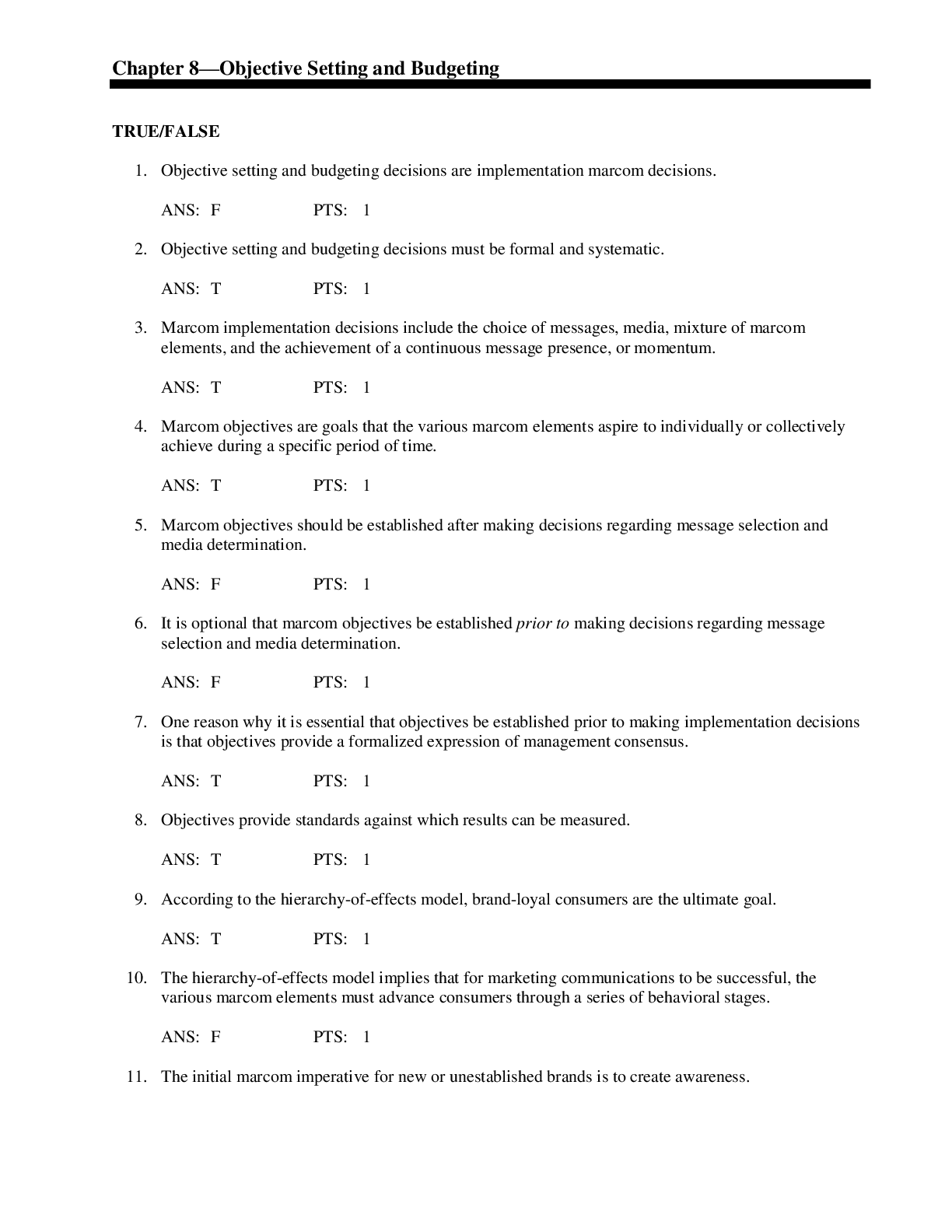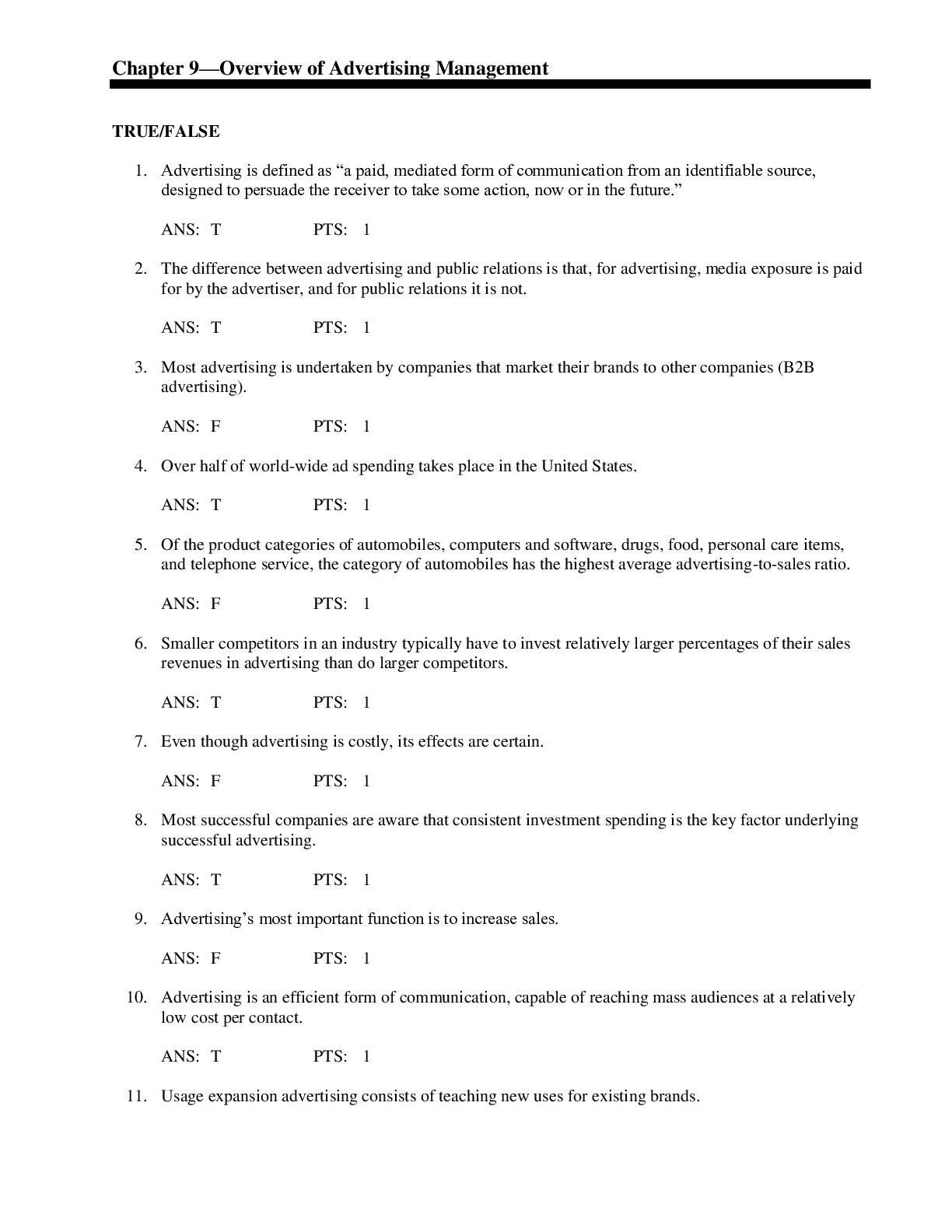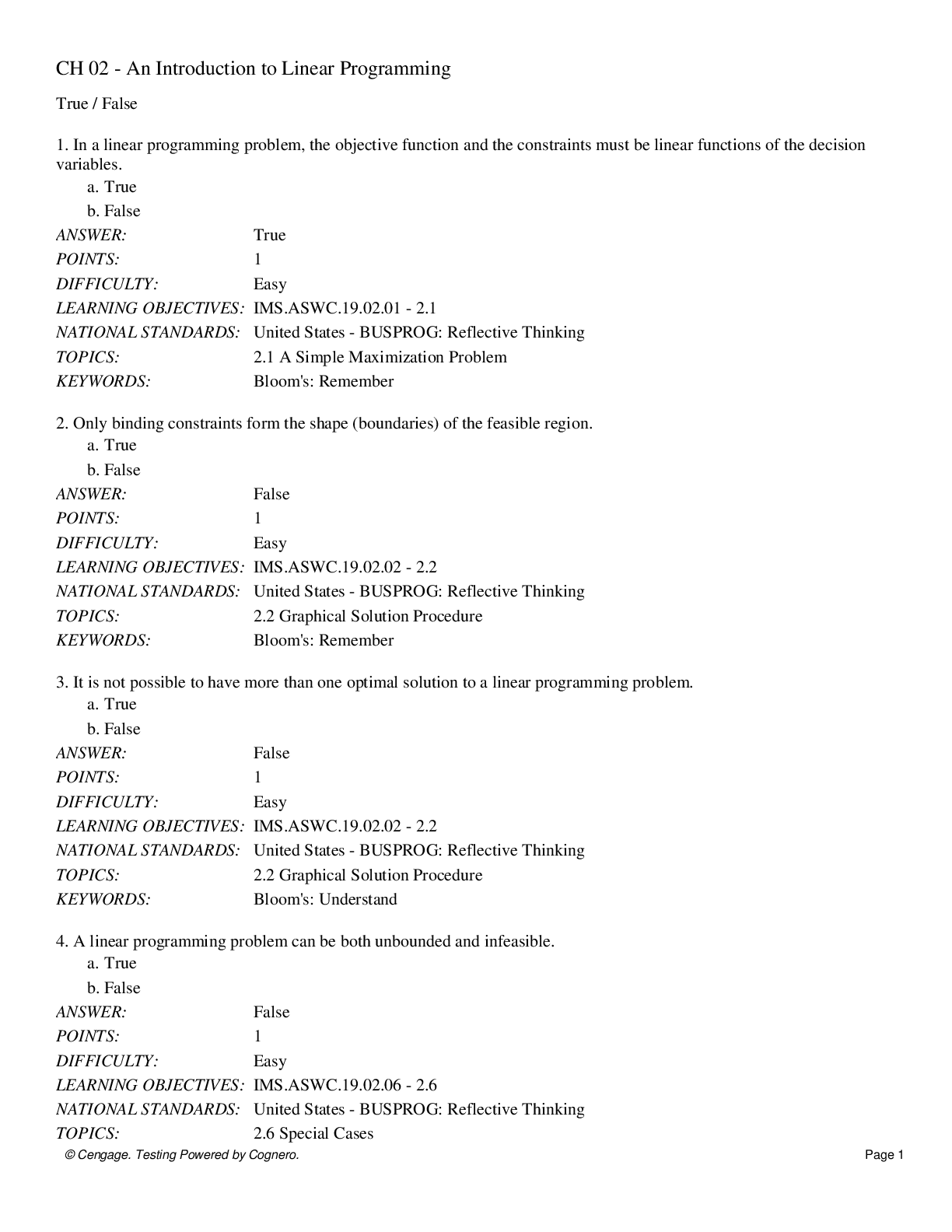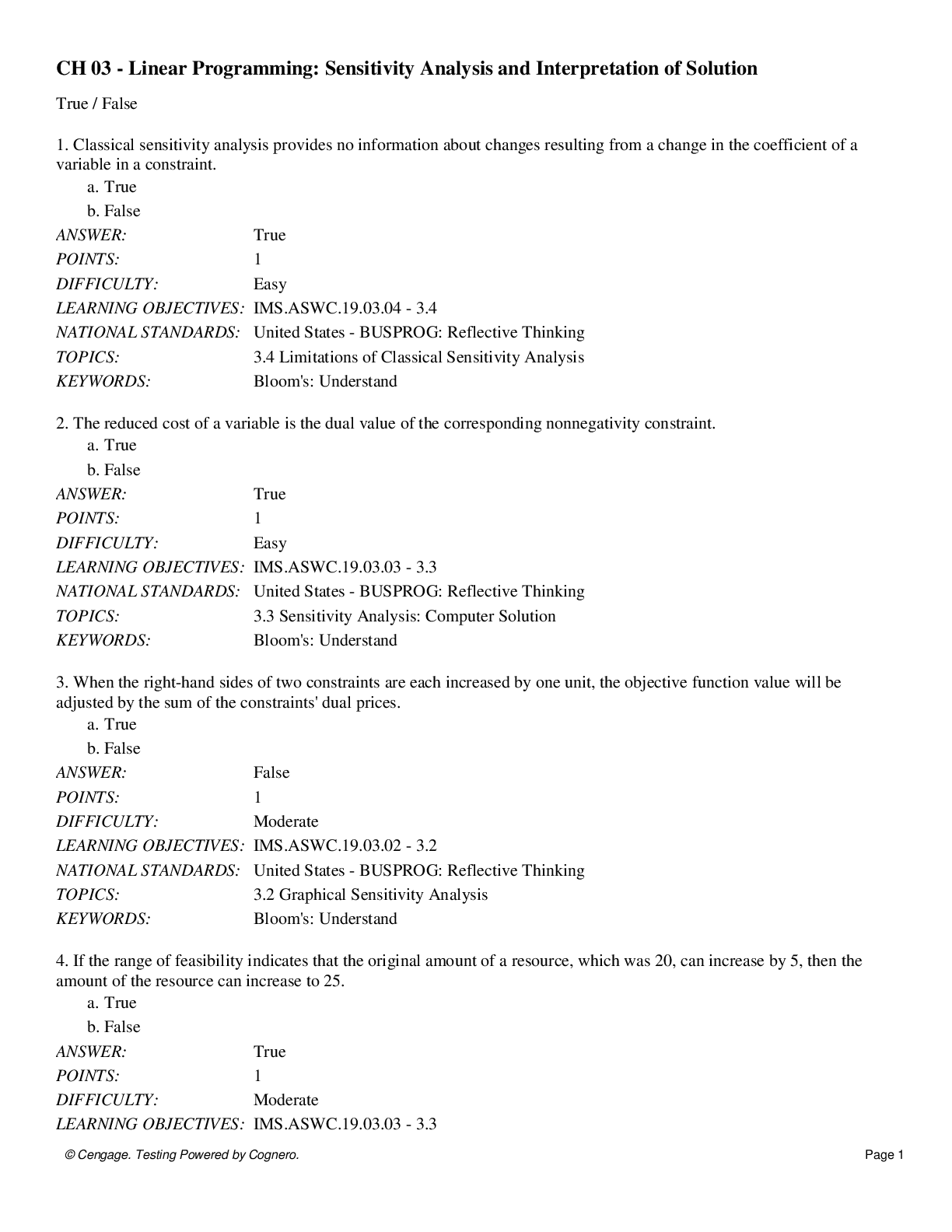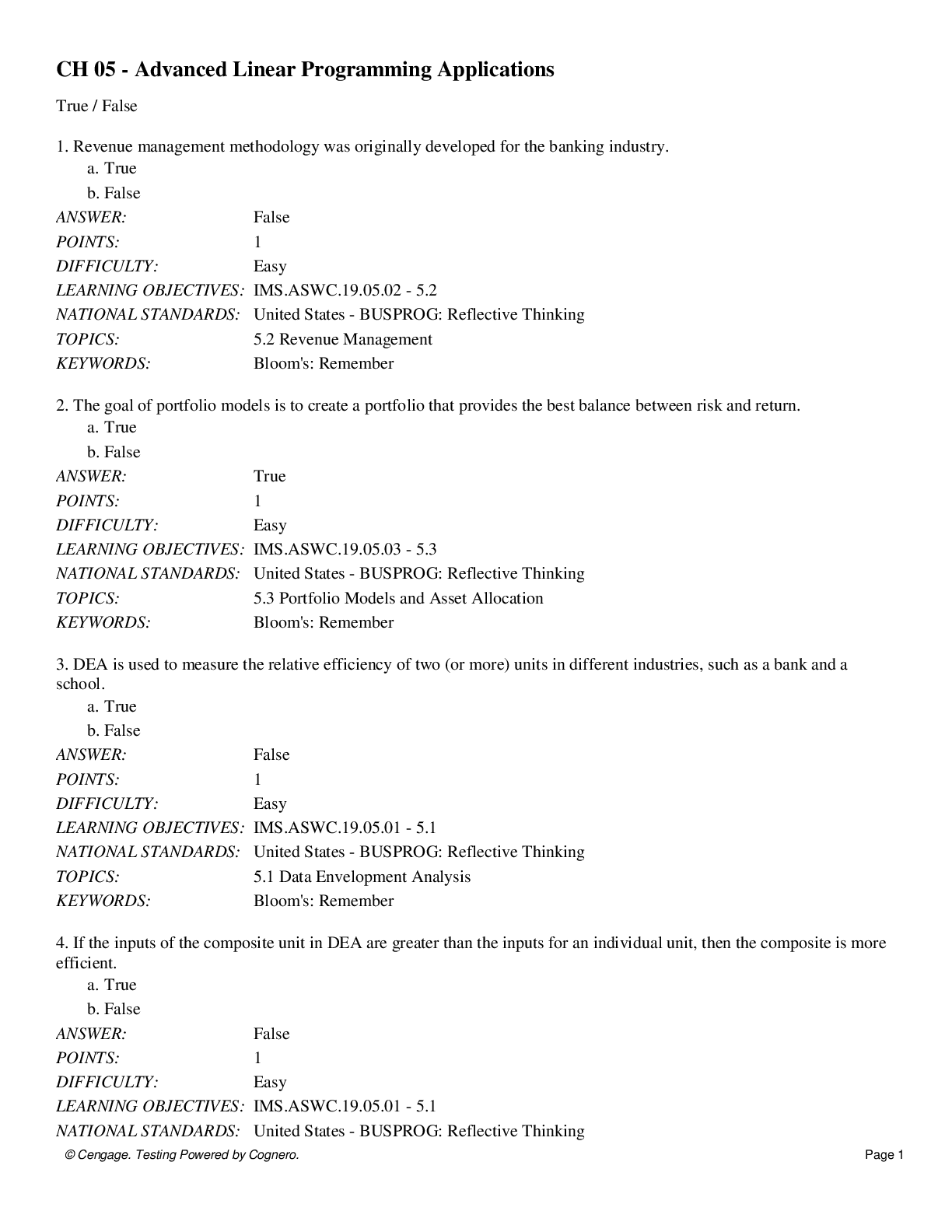*NURSING > QUESTIONS & ANSWERS > NURSING 101 Renal meds practice questions and Answers (Latest Summer 2020) (All)
NURSING 101 Renal meds practice questions and Answers (Latest Summer 2020)
Document Content and Description Below
Renal Meds Review Questions A client who has a cold is seen in the emergency department with an inability to void. Because the client has a history of benign prostatic hyperplasia, the nurse determi... nes that the client should be questioned about the use of which medication? 1. Diuretics 2. Antibiotics 3. Antitussives 4. Decongestants 1. Nitrofurantoin (Macrodantin) is prescribed for a client with a urinary tract infection. The client contacts the nurse and reports a cough, chills, fever, and difficulty breathing. The nurse should make which interpretation about the client's complaints? 1. The client may have contracted the flu. 2. The client is experiencing anaphylaxis. 3. The client is experiencing expected effects of the medication. 4. The client is experiencing a pulmonary reaction requiring cessation of the medication. The nurse is providing discharge instructions to a client receiving sulfamethoxazole. Which instruction should be included in the list? 1. Restrict fluid intake. 2. Maintain a high fluid intake. 3. If the urine turns dark brown, call the health care provider (HCP) immediately. 4. Decrease the dosage when symptoms are improving to prevent an allergic response. Trimethoprim-sulfamethoxazole (TMP-SMZ; Bactrim) is prescribed for a client. The nurse should instruct the client to report which symptom if it develops during the course of this medication therapy? 1. Nausea 2. Diarrhea 3. Headache 4. Sore throat 2. Phenazopyridine (Pyridium) is prescribed for a client for symptomatic relief of pain resulting from a lower urinary tract infection. The nurse should provide the client with which information regarding this medication? 1. Take the medication at bedtime. 2. Take the medication before meals. 3. Discontinue the medication if a headache occurs. 4. A reddish orange discoloration of the urine may occur. 1. Bethanechol chloride (Urecholine) is prescribed for a client with urinary retention. Which disorder would be a contraindication to the administration of this medication? 1. Gastric atony 2. Urinary strictures 3. Neurogenic atony 4. Gastroesophageal reflux 2. The nurse, who is administering bethanechol chloride (Urecholine), is monitoring for cholinergic overdose associated with the medication. The nurse should check the client for which sign of overdose? 1. Dry skin 2. Dry mouth 3. Bradycardia 4. Signs of dehydration 3. Oxybutynin chloride (Ditropan XL) is prescribed for a client with neurogenic bladder. Which sign would indicate a possible toxic effect related to this medication? 1. Pallor 2. Drowsiness 3. Bradycardia 4. Restlessness 4. Following kidney transplantation, cyclosporine (Sandimmune) is prescribed for a client. Which laboratory result would indicate an adverse effect from the use of this medication? 1. Normal hemoglobin level 2. Decreased creatinine level 3. Decreased white blood cell count 4. Elevated blood urea nitrogen level 5. The nurse is providing dietary instructions to a client who has been prescribed cyclosporine (Sandimmune). Which food item should the nurse instruct the client to exclude from the diet? 1. Red meats 2. Orange juice 3. Grapefruit juice 4. Green leafy vegetables 6. Tacrolimus (Prograf) is prescribed for a client. Which disorder, if noted in the client's record, would indicate that the medication needs to be administered with caution? 1. Pancreatitis 2. Ulcerative colitis 3. Diabetes insipidus 4. Coronary artery disease 7. The nurse is reviewing the laboratory results for a client receiving tacrolimus (Prograf). Which laboratory result would indicate to the nurse that the client is experiencing an adverse effect of the medication? 1. Blood glucose of 200 mg/dL 2. Potassium level of 3.8 mEq/L 3. Platelet count of 300,000 cells/mm3 4. White blood cell count of 6000 cells/mm3 8. The nurse receives a call from a client concerned about eliminating brown-colored urine after taking nitrofurantoin (Furadantin) for a urinary tract infection. The nurse should make which appropriate response? 1. "Discontinue taking the medication and make an appointment for a urine culture." 2. "Decrease your medication to half the dose because your urine is too concentrated." 3. "Continue taking the medication because the urine is discolored from the medication." 4. "Take magnesium hydroxide (Maalox) with your medication to lighten the urine color." 9. A client with chronic kidney disease is receiving epoetin alfa (Epogen). Which laboratory result would indicate a therapeutic effect of the medication? 1. Hematocrit of 32% 2. Platelet count of 400,000 cells/mm3 3. Blood urea nitrogen level of 15 mg/dL 4. White blood cell count of 6000 cells/mm3 10. A client with a urinary tract infection is receiving ciprofloxacin (Cipro) by the intravenous (IV) route. The nurse appropriately administers the medication by performing which action? 1. Infusing slowly over 60 minutes 2. Infusing in a light-protective bag 3. Infusing only through a central line 4. Infusing rapidly as a direct intravenous push medication 11. Nitrofurantoin (Macrobid), a urinary antiseptic, is prescribed for the client. The nurse checks the client's record, knowing that this medication is contraindicated in which disorder? 1. Heart failure 2. Renal disease 3. Hepatic disease 4. Diabetes insipidus 12. Bethanechol chloride (Urecholine) is prescribed for the client. The nurse instructs the client to take the medication at which time? 1. With meals 2. Two hours after meals 3. With a snack in the afternoon 4. At bedtime with crackers and cheese 13. Epoetin alfa (Epogen) is prescribed for a client diagnosed with chronic kidney disease. The client asks the nurse about the purpose of the medication. The nurse should make which most appropriate response? 1. "It is used to treat anemia." 2. "It is used to lower your blood pressure." 3. "It will help to increase the potassium level in your body." 4. "It is an anticonvulsant medication given to all clients after dialysis to prevent seizure activity." 14. Tamsulosin hydrochloride (Flomax) is prescribed for a client. The nurse should suspect the medication is prescribed to relieve which condition? 1. Constipation 2. Muscle spasms 3. Urinary obstruction 4. Respiratory congestion 15. Tamsulosin hydrochloride (Flomax) has been prescribed for a client with benign prostatic hypertrophy (BPH). How should the nurse instruct the client to take the medication? 1. With breakfast 2. With a glass of milk 3. 30 minutes after a meal 4. With the lunchtime meal 16. A client who has had a prostatectomy is complaining of pain from bladder spasms. The nurse checks the health care provider's prescription sheet and expects to see which medication prescribed to treat the problem? 1. Morphine sulfate 2. Oxybutynin (Ditropan) 3. Hydromorphone (Dilaudid) 4. Meperidine hydrochloride (Demerol) 17. A client with chronic kidney disease has a medication prescription for epoetin alfa (Epogen). The nurse should plan to administer this medication by which method? 1. Subcutaneously 2. Intramuscularly 3. With a full glass of water 4. Diluted in juice to enhance taste 18. A client with chronic kidney disease (CKD) who is receiving an antihypertensive medication is experiencing frequent hypotensive episodes. The nurse reviews the client's medication record, knowing that which medication would have the greatest tendency to cause hypotension? 1. Methyldopa (Aldomet) 2. Calcium carbonate (Os-Cal) 3. Levothyroxine (Synthroid) 4. Epoetin alfa (Epogen, Procrit) 19. Norfloxacin (Noroxin) is prescribed for a client with a Pseudomonas infection of the urinary tract. The nurse should instruct the client to take the medication at what time? 1. With meals 2. At bedtime 3. 2 hours after meals 4. With a snack in the late afternoon 20. Nitrofurantoin (Macrodantin) is prescribed for an adult client for treatment of acute urinary tract infection (UTI). The nurse reviews the health care provider's prescription knowing that which dosage is the normal adult dosage? 1. 50 mg every 6 hours 2. 150 mg three times daily 3. 300 mg administered at bedtime 4. 1 g distributed evenly throughout the day 21. Methenamine (Mandelamine) is prescribed for a client with a chronic urinary tract infection. In planning for administration of the medication, the nurse understands that the mechanism of action of this medication can be described as which action? 1. It decreases bladder muscle spasms. 2. It inhibits the replication of bacterial DNA. 3. It relaxes smooth muscles of the urinary tract. 4. It decomposes into ammonia and formaldehyde and denatures bacterial proteins. 22. Nalidixic acid (NegGram) is prescribed for an adult client with a urinary tract infection (UTI). In planning for administration, the nurse understands that the normal adult dosage for this medication is which dosage? 1. 250 mg administered twice daily 2. 500 mg daily administered at bedtime 3. 100 mg administered three times daily 4. 1 g four times daily for a period of 1 week 23. Bethanechol chloride (Urecholine) is prescribed for a client with postoperative bladder spasms. In planning for administration, the nurse reviews the health care provider's prescription, knowing that the normal adult oral dosage for this medication is which dosage? 1. 100 mg at bedtime 2. 100 mg every 4 hours 3. 10 to 50 mg three to four times a day 4. 50 to 100 mg three to four times a day 24. Bethanechol chloride (Urecholine) by injection is prescribed for a client with urinary retention. The nurse anticipates that this medication will be prescribed by which route? 1. Intravenously 2. Intradermally 3. Intramuscularly 4. Subcutaneously 25. Aluminum hydroxide (Amphojel) is prescribed for a client with chronic kidney disease (CKD). The nurse should instruct the client to take this medication at what time? 1. At bedtime 2. With meals 3. On an empty stomach 4. In the morning on arising 26. A client taking metronidazole telephones the home health nurse to report dark discoloration to the urine. The nurse interprets that the client's complaint warrants which nursing action at this time? 1. Instruct the client to increase fluid intake. 2. Tell the client to discontinue the medication. 3. Instruct the client to call the health care provider (HCP). 4. Tell the client that this is a harmless medication side effect. 27. A client being admitted to the nursing unit has been taking bethanechol chloride (Urecholine) at home. During the admission assessment, the nurse gives special attention to assessing the client for which as a side effect of this medication? 1. Bradycardia 2. Constipation 3. Hypertension 4. Decreased sweating or dry mouth, or both 28. The nurse has a prescription to administer bethanechol chloride (Urecholine) subcutaneously. Before giving this medication, the nurse should ensure that which medication is available? 1. Phytonadione 2. Atropine sulfate 3. Calcium chloride 4. Protamine sulfate 29. A client with acute pyelonephritis who was started on antibiotic therapy 24 hours earlier is still complaining of burning with urination. The nurse should check the health care provider's prescriptions to see if which medication is prescribed? 1. Phenazopyridine (Pyridium) 2. Oxybutynin chloride (Ditropan XL) 3. Bethanechol chloride (Urecholine) 4. Propantheline bromide (Pro-Banthine) 30. A home health nurse is caring for a client who is taking probenecid. The client has been instructed to restrict the diet to low-purine foods. Which food item should the nurse instruct the client to avoid? 1. Spinach 2. Scallops 3. Potatoes 4. Ice cream 31. A nurse is planning to administer furosemide (Lasix) 40 mg by intravenous push (IVP) through an existing line. To deliver this medication safely, the nurse should perform which action? 1. Give the medication rapidly over 10 seconds. 2. Give the medication slowly diluted in 100 mL of 5% dextrose in water. 3. Pinch the IV tubing above the injection port, and slowly inject over 1 to 2 minutes. 4. Pinch the IV tubing below the injection port, and inject slowly over 1 to 2 minutes. 32. Methenamine mandelate is prescribed for the client with a gram-positive urinary tract infection. Which condition, if noted in the client's record, would alert the nurse to question the prescription for this medication? 1. Hypothyroidism 2. Diabetes mellitus 3. Cirrhosis of the liver 4. Peripheral vascular disease 33. Laboratory analysis of a urine sample for culture and sensitivity reveals a bacterial infection and the client is diagnosed with cystitis. Nitrofurantoin is prescribed for the client. Which baseline assessment would be the priority before administering the medication? 1. Checking lung sounds 2. Checking the apical heart rate 3. Checking the blood pressure 4. Checking the bowel sounds in all four quadrants 34. A nurse provides instructions regarding the administration of liquid oral cyclosporine (Sandimmune) solution to a client. Which statement, if made by the client, would indicate the need for further instruction? 1. "I need to mix the concentrate well and drink it immediately." 2. "I will mix the concentrate with orange juice to improve the taste." 3. "I will purchase a dropper from the pharmacist to calibrate the amount of medication that I need." 4. "After taking the medication, I need to rinse the container with diluent and drink it to ensure that I have taken the complete dose." 35. Nitrofurantoin is prescribed for the client with a urinary tract infection. The nurse is instructing the client regarding the administration of the medication. At which best time should the nurse tell the client to take the medication? 1. At bedtime 2. With meals 3. One hour before the dinner meal 4. In the morning two hours after breakfast 36. Trimethoprim-sulfamethoxazole is prescribed to be administered by intravenous infusion to a client with a recurrent urinary tract infection. How should a nurse administer this medication? 1. Over 30 minutes 2. Over 60 to 90 minutes 3. Piggybacked into the peripheral line containing parenteral nutrition 4. Piggybacked into the existing infusion of normal saline and potassium chloride 37. Propantheline bromide is prescribed for a client with bladder spasms. Which disorder, if noted in the client's record, should alert a nurse to question the prescription for this medication? 1. Glaucoma 2. Myxedema 3. Hypothyroidism 4. Coronary artery disease 38. Oxybutynin is prescribed for a client. Based on this prescription, the nurse suspects that the client has which condition? 1. Gastritis 2. Renal calculi 3. Ulcerative colitis 4. Overactive bladder 39. A nurse should expect the client receiving oxybutynin to report which side effect? 1. Itching 2. Diarrhea 3. Swelling 4. Dry mouth 40. Which is the therapeutic outcome of dutasteride (Avodart) therapy? 1. Improved erectile function 2. A reduction in blood pressure 3. Decreased obstruction to outflow of urine through the urethra 4. Decreased low-density lipoproteins and increased high-density lipoproteins 41. An ambulatory care nurse is providing instructions to a client with a urinary tract infection (UTI) being started on medication therapy with nitrofurantoin (Macrodantin), a urinary antiseptic agent. The nurse should provide the client with which information? 1. It can cause urinary retention. 2. It will cause the urine to become clear. 3. The sun should be avoided because it is a sulfa-based medication. 4. If taken with meals, it will help decrease the risk for gastrointestinal (GI) upset. 42. A client is beginning to take trimethoprim-sulfamethoxazole (Bactrim) for a recurrent urinary tract infection (UTI). The nurse would give the client which instruction regarding this medication? 1. Expect rashes or skin changes as a result of therapy. 2. Discontinue the medication when symptoms subside. 3. Take most doses early in the day when fluid intake is greatest. 4. Take each dose with 8 oz of water, and drink extra water each day. 43. A client with a urinary tract infection (UTI) has dysuria and is given a prescription for phenazopyridine (Pyridium) for symptom relief. The nurse provides medication information and should provide the client with which information? 1. Take the medication at bedtime. 2. Take the medication before meals. 3. Expect the urine to become reddish-orange. 4. Notify the health care provider if headache occurs. 44. The nurse is preparing a subcutaneous dose of bethanechol (Urecholine) prescribed for a client with urinary retention. Before giving the dose, the nurse checks to see that which medication is available on the emergency cart for use if needed? 1. Vitamin K 2. Mucomyst 3. Atropine sulfate 4. Protamine sulfate 45. A nurse is administering a dose of a prescribed diuretic to an assigned client. The nurse should monitor the client for hypokalemia as a side effect of therapy if the client has been receiving which medication? 1. Bumetanide 2. Triamterene (Dyrenium) 3. Amiloride HCl (Midamor) 4. Spironolactone (Aldactone) [Show More]
Last updated: 1 year ago
Preview 1 out of 22 pages
Instant download
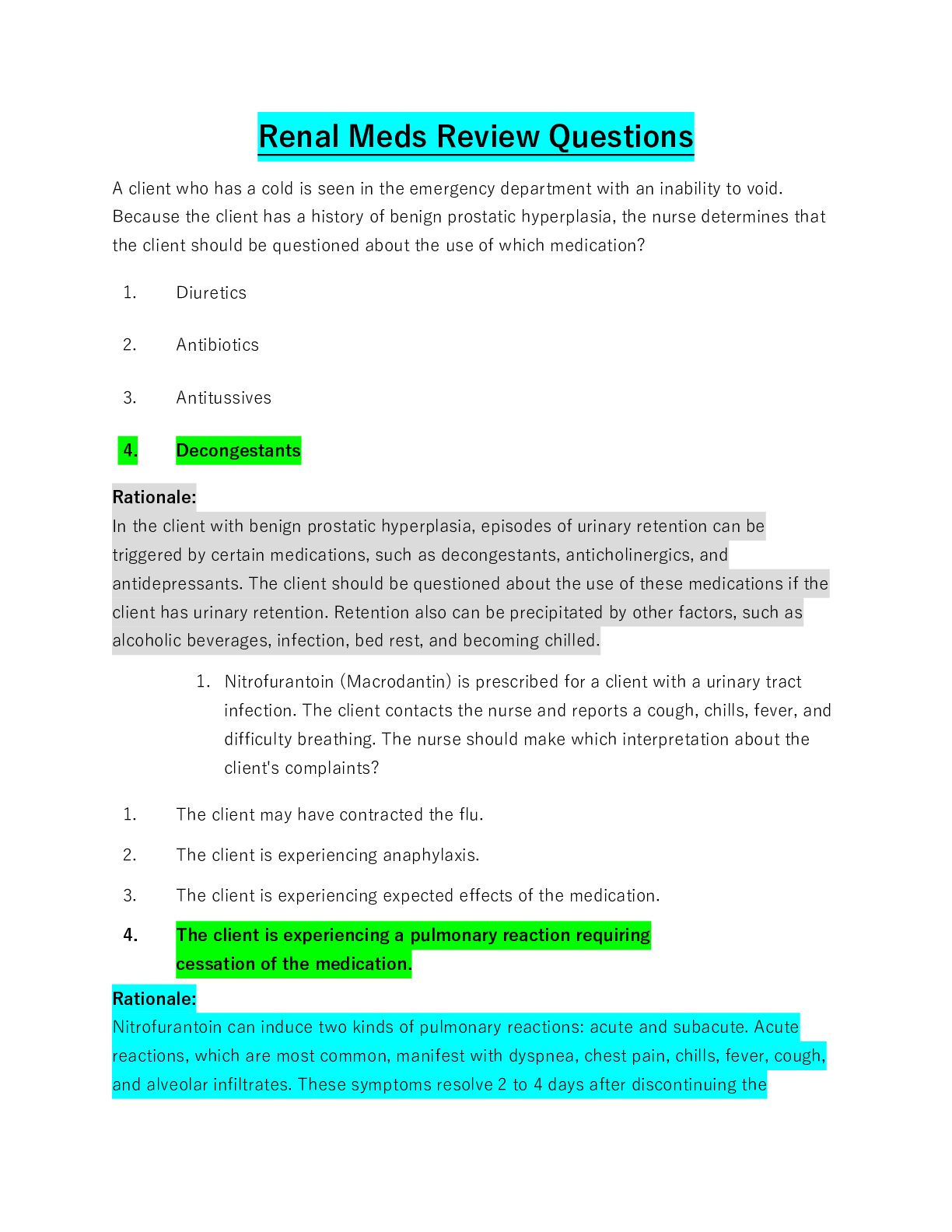
Buy this document to get the full access instantly
Instant Download Access after purchase
Add to cartInstant download
Reviews( 0 )
Document information
Connected school, study & course
About the document
Uploaded On
Sep 08, 2020
Number of pages
22
Written in
Additional information
This document has been written for:
Uploaded
Sep 08, 2020
Downloads
0
Views
45

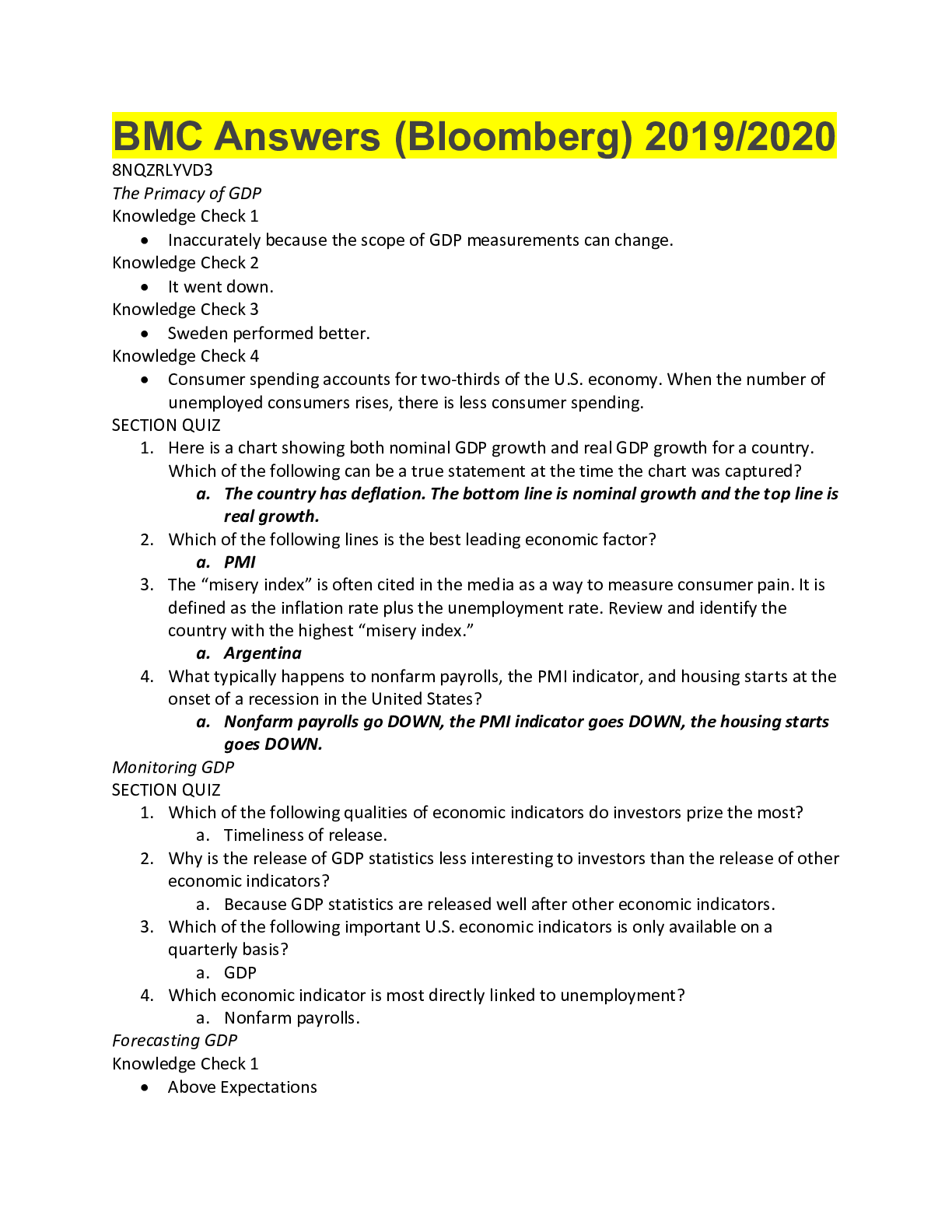
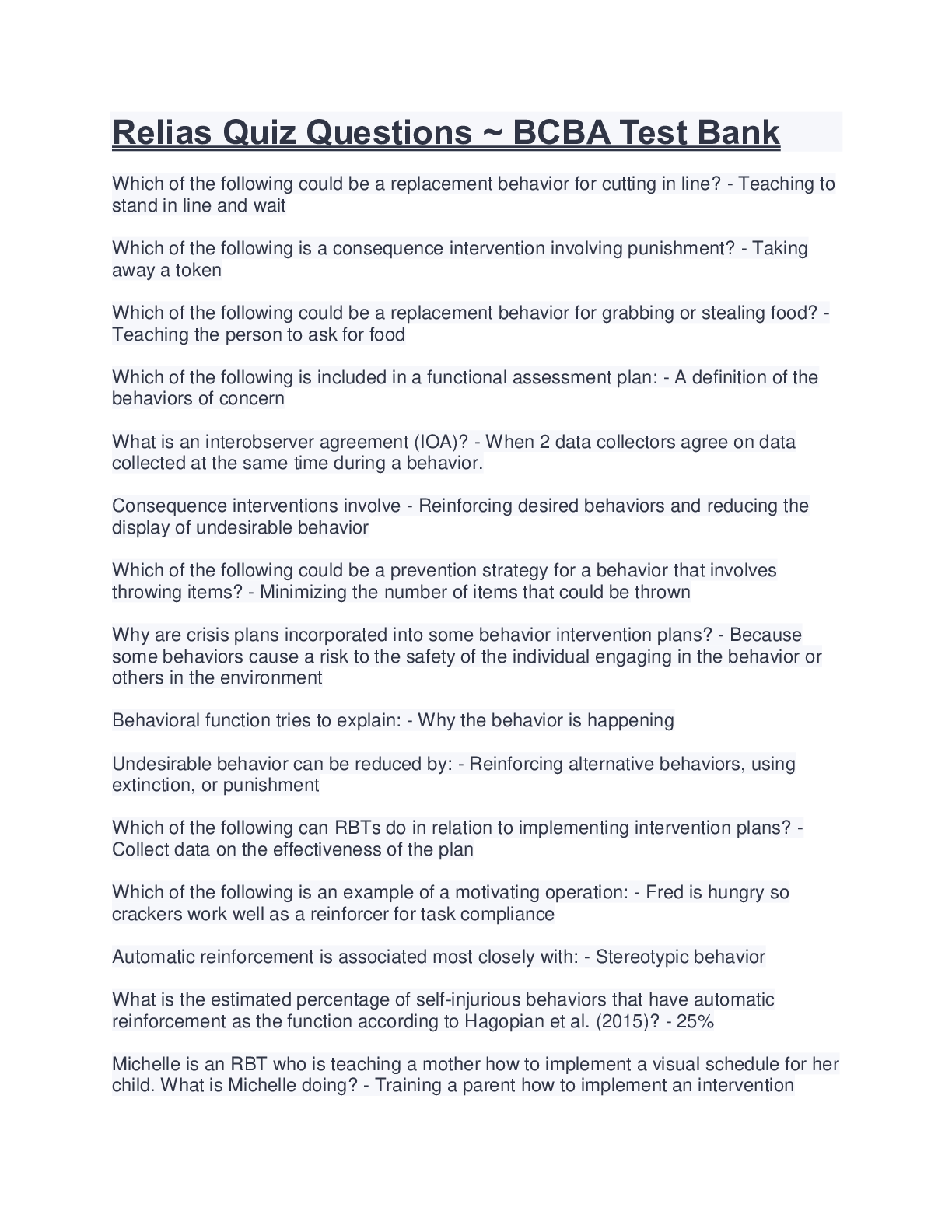
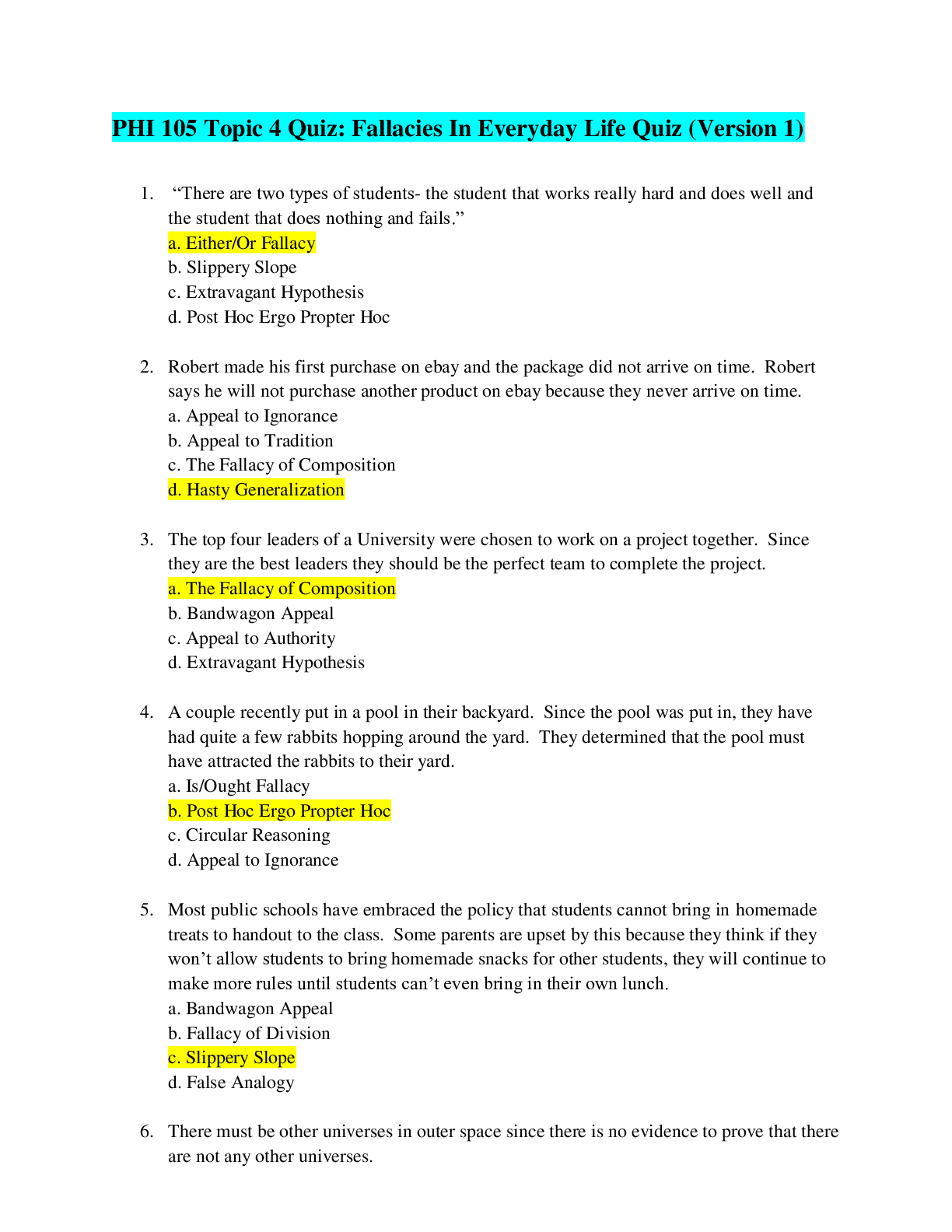


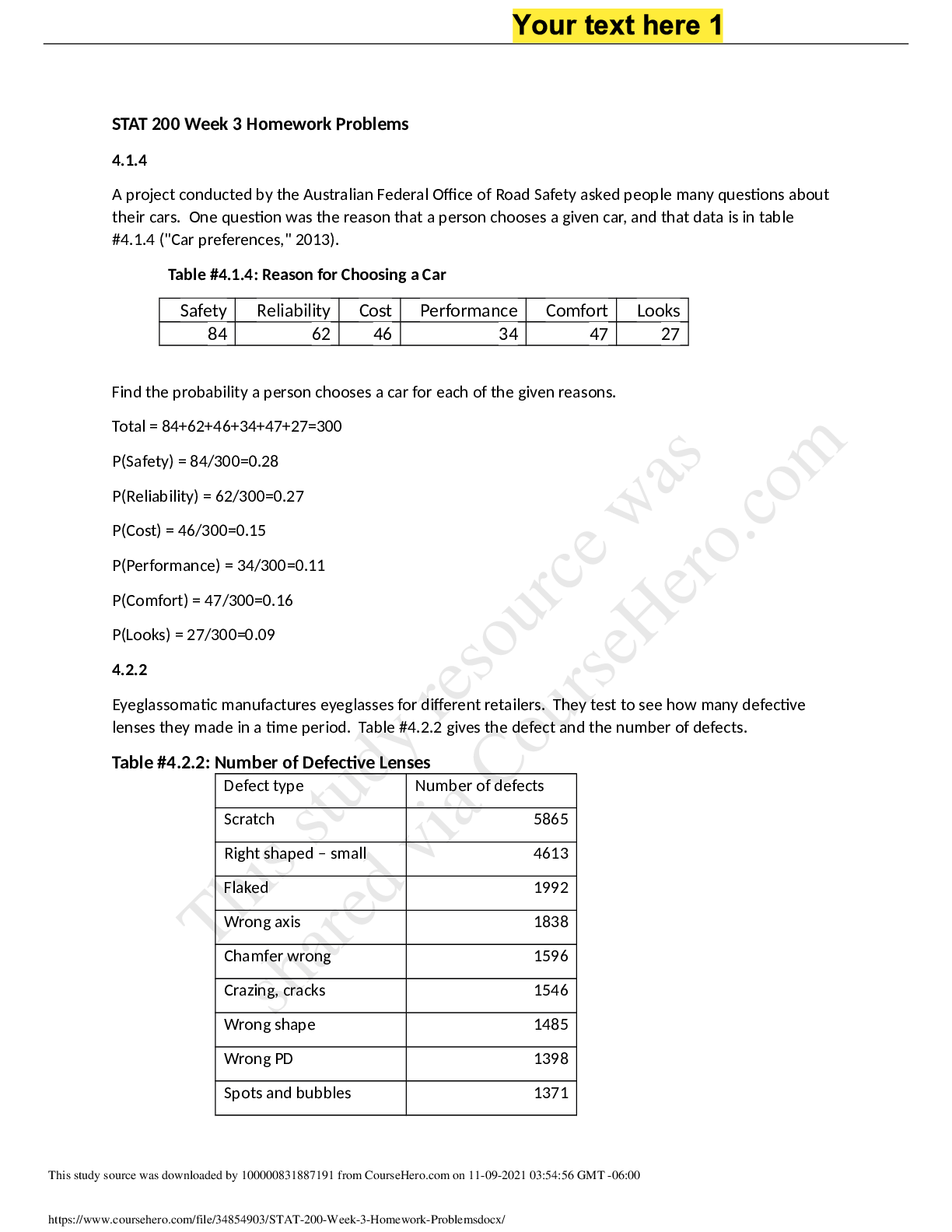

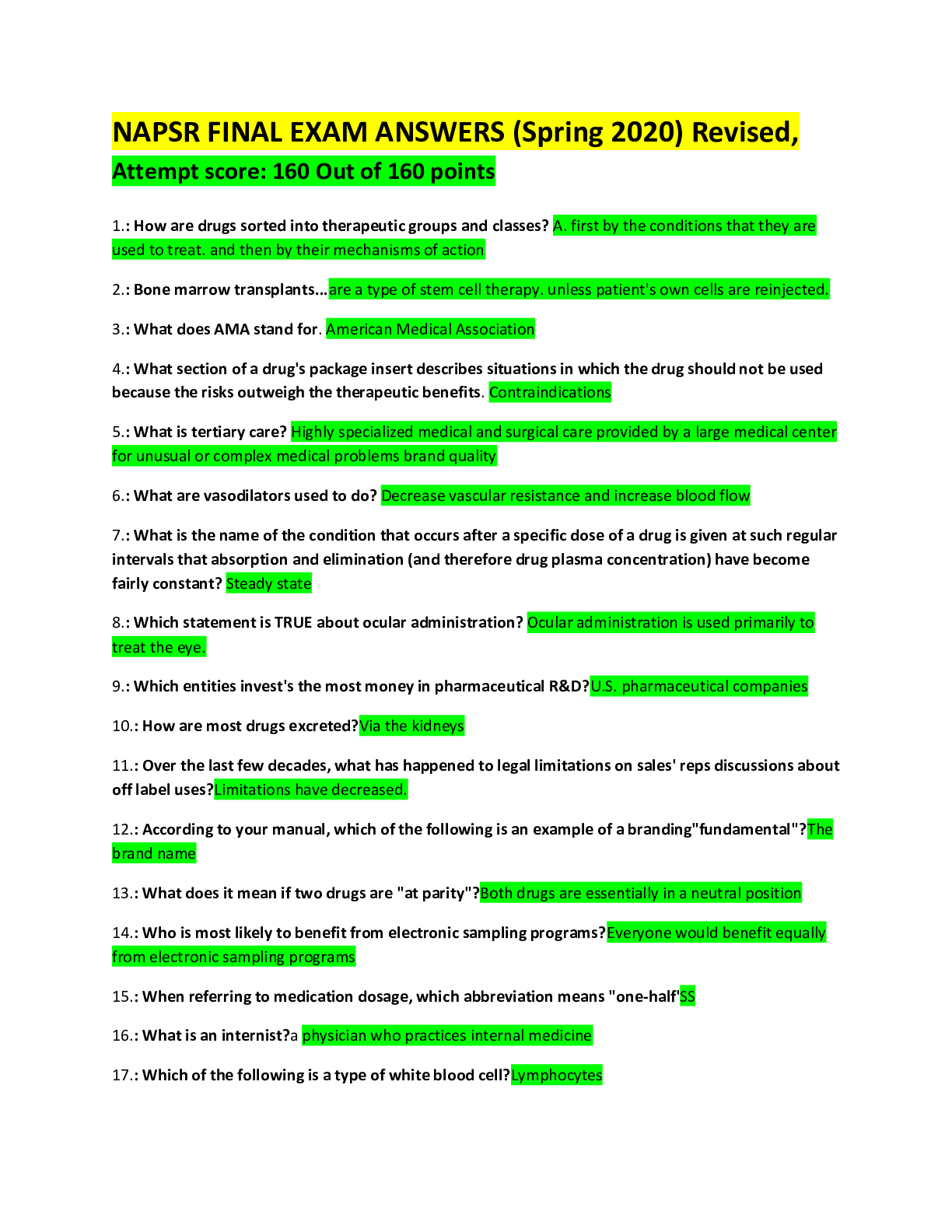

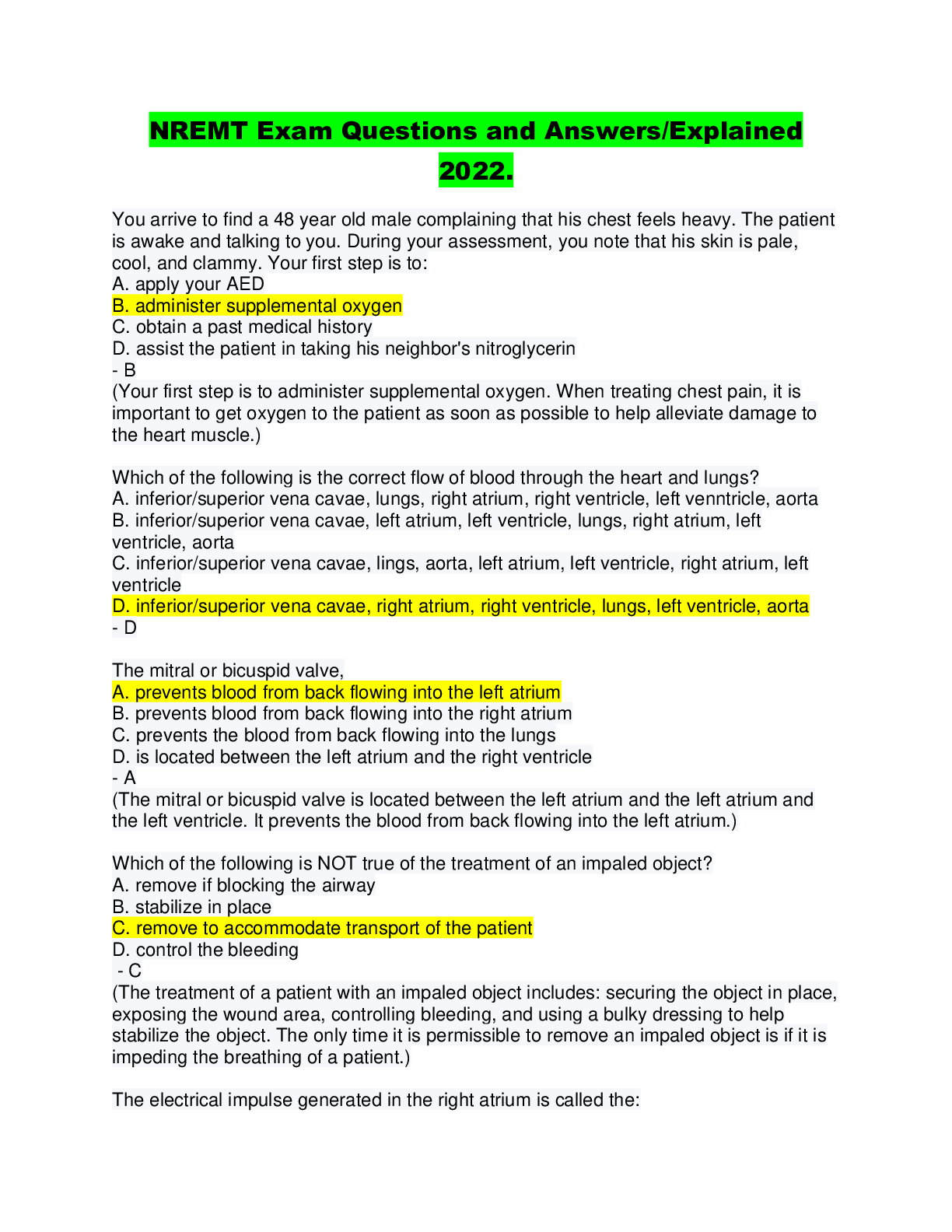
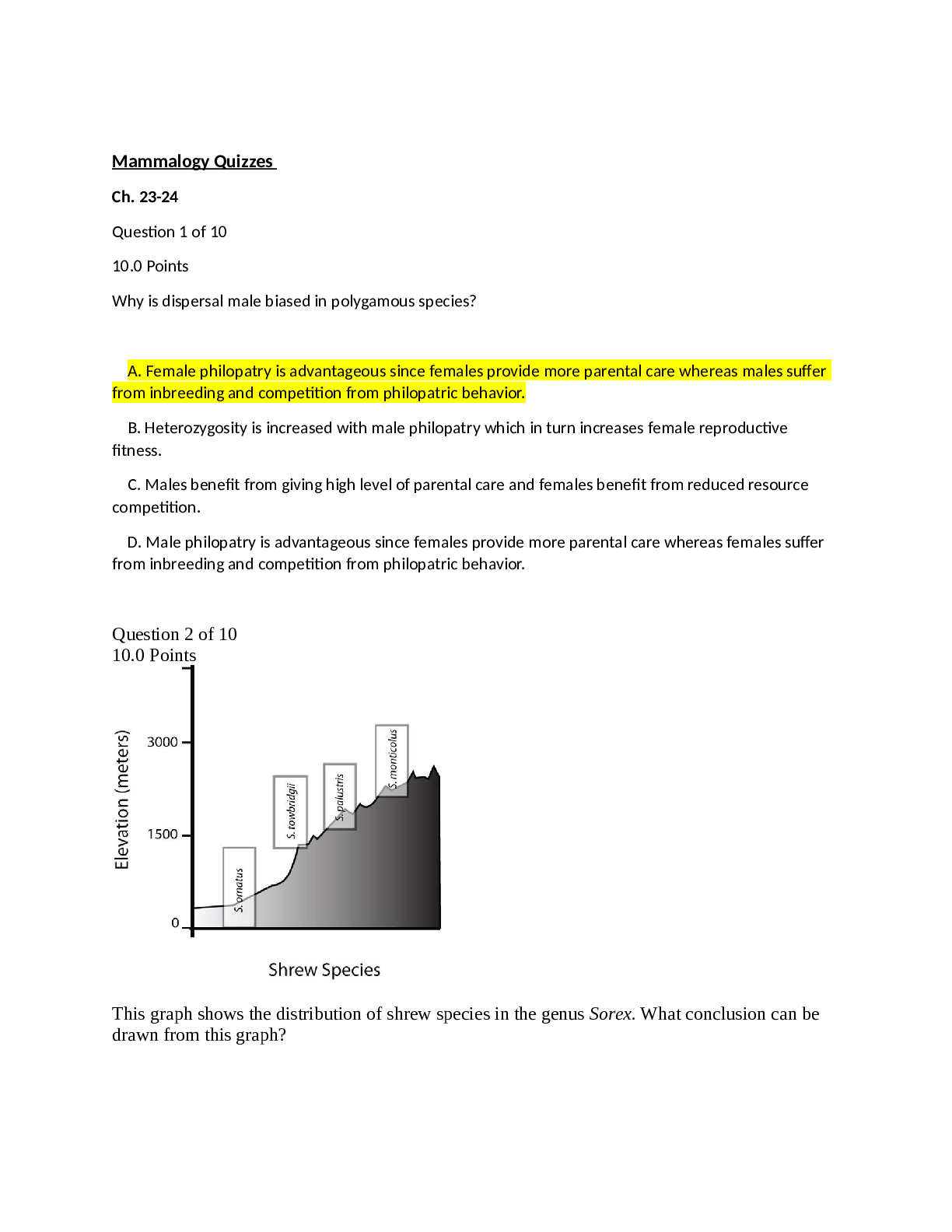
.png)




